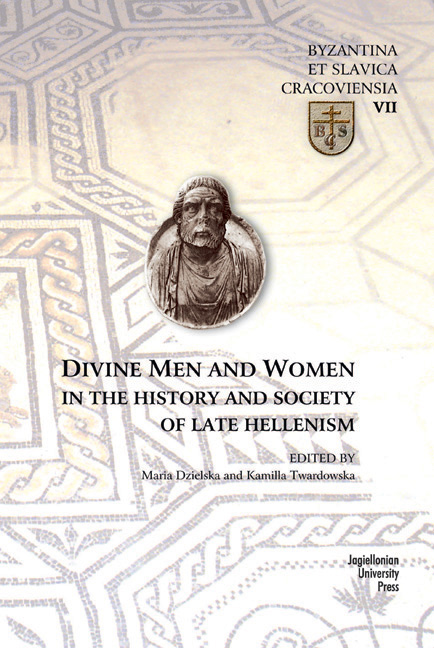Book contents
- Frontmatter
- Contents
- Foreword
- Introduction
- List of participants
- The Divine Man of Late Hellenism: A Sociable and Popular Figure
- Praying, Wonder-Making and Advertising: The Epitynchanoi's Funerary Inscriptions
- Philosophy and Culture as Means to Divine Ascent in Late Antiquity: The Case of Synesius
- Once More on Hypatia's Death
- Boethius — Divine Man or Christian Philospopher?
- Aspects of Divinization According to Farīd-al-dīn ʿAṭṭār Nīšāpūrī (died c. 1221)
- Lecture Halls at Kom el-Dikka in Alexandria
- Salustios — Divine Man of Cynicism in Late Antiquity
- Sosipatra — Role Models for ‘Divine’ Women in Late Antiquity
- Athenais Eudocia — Divine or Christian Woman?
- Damascius' Isidore: Collective Biography and a Perfectly Imperfect Philosophical Exemplar
- Conference photo gallery
The Divine Man of Late Hellenism: A Sociable and Popular Figure
Published online by Cambridge University Press: 05 December 2014
- Frontmatter
- Contents
- Foreword
- Introduction
- List of participants
- The Divine Man of Late Hellenism: A Sociable and Popular Figure
- Praying, Wonder-Making and Advertising: The Epitynchanoi's Funerary Inscriptions
- Philosophy and Culture as Means to Divine Ascent in Late Antiquity: The Case of Synesius
- Once More on Hypatia's Death
- Boethius — Divine Man or Christian Philospopher?
- Aspects of Divinization According to Farīd-al-dīn ʿAṭṭār Nīšāpūrī (died c. 1221)
- Lecture Halls at Kom el-Dikka in Alexandria
- Salustios — Divine Man of Cynicism in Late Antiquity
- Sosipatra — Role Models for ‘Divine’ Women in Late Antiquity
- Athenais Eudocia — Divine or Christian Woman?
- Damascius' Isidore: Collective Biography and a Perfectly Imperfect Philosophical Exemplar
- Conference photo gallery
Summary
I. The θεȋoς ἀνήρ
1. Social reality or scholarly construct?
The first question that springs to mind when confronted with the theme of this volume is a methodological one: is the term θεȋoς ἀνήρ a recent coinage — a modern convention, like, say, “Neoplatonism” — or is it contemporary with the society we are studying? Even a quick glance at the evidence reveals that the formula is ancient and, what is more, of regular usage in late antique society. It was an expression to which people had recourse in order to describe a familiar type, a figure who played a role in their lives both as an ideal and a reality. And if we were to compare it with the term “Second Sophistic”, which is a methodological construct invented by a chronicler to legitimise a social trend by transforming it into a consistent intellectual movement, we would immediately see how much more weight it carried in contemporary society; for, unlike the “Second Sophistic”, an expression that would have meant nothing to people outside Philostratus' own narrow circle, the term θεȋoς ἀνήρ corresponds to a concept created and nurtured to meet the needs of an entire society. Whichever way one approaches the subject therefore, it is not possible to deconstruct it along the lines dictated by the “methodologies of suspicion” the notion and reality of the θεȋoς ἀνήρ is firmly embedded in the society of late antiquity.
- Type
- Chapter
- Information
- Publisher: Jagiellonian University PressPrint publication year: 2013



